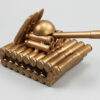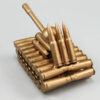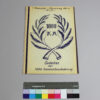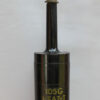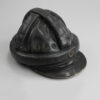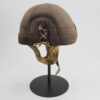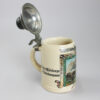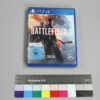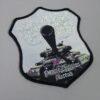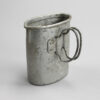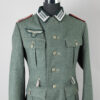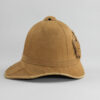Souvenir made from ammunition casings, 2022
Inventory number: DPM 7.276
The Socialist Federal Republic of Yugoslavia disintegrated in the 1990s. The Yugoslav republic of Bosnia and Herzegovina was proclaimed an independent republic in 1992 and recognized by the European Community (now the EU) and the USA. The ethnic-political tensions between the Bosniaks, Croats and Serbs in the country then culminated in a civil war in which ethnic cleansing and numerous crimes were committed. Despite an arms embargo, the war lasted until 1995, in which UN troops were also involved. To this day, Bosnia and Herzegovina is still partly under international military and political control.
In Sarajevo, the capital of Bosnia and Herzegovina, traces of the war can still be seen today. Many houses still show bullet holes. The Bosniak-Muslim city was besieged by the Bosnian Serb army for almost four years. Tanks were also used in the siege of Sarajevo. The city lies in a valley and during the siege the Bosnian Serb army positioned artillery, mortars and tanks on the surrounding hills. The town was the seat of government and foreign NGOs, journalists and UN soldiers were also present. Artillery fire and the massive use of snipers killed many civilians and left a deep mark on the collective memory of the Bosniaks.
The war is also still present today in the souvenir stalls in the historic old town: in addition to items of equipment, remnants of the war are also artistically processed there. Sarajevo has a long tradition of metal craftsmanship; as early as the 16th century, coppersmiths in the then Ottoman city were given their own bazaar for their wares. In Coppersmiths’ Lane, you can find tea sets and decorative plates as well as pens made from artillery and rifle shells, flower vases and armored figures. After the end of the war, some of the coppersmiths began to collect the masses of material available in the region and process it into useful, beautiful items and souvenirs for tourists. The tank figure is made from different types of ammunition. The numbers on some of the gold-colored casings indicate that they were manufactured in China at the end of the 1970s. In addition to the Chinese People’s Liberation Army, the M 43 short cartridge was also used by the Red Army and the armies of the Warsaw Treaty Organization. This ammunition could have been fired during the Bosnian War and come from Yugoslavian leftover stocks of Chinese export goods or could have been purchased later for the manufacture of the souvenirs.
Object of the month
(short) stories from the depot
Unfortunately, many objects cannot currently be shown in the exhibition for conservation reasons. Here you will find unusual objects and exciting stories of special pieces from the depot


